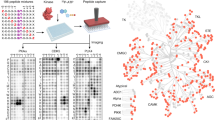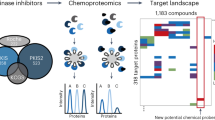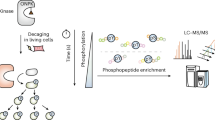Abstract
Aberrant AKT activation is prevalent across multiple human cancer lineages providing an important new target for therapy. Twenty-two independent phosphorylation sites have been identified on specific AKT isoforms likely contributing to differential isoform regulation. However, the mechanisms regulating phosphorylation of individual AKT isoform molecules have not been elucidated because of the lack of robust approaches able to assess phosphorylation of multiple sites on a single AKT molecule. Using a nanofluidic proteomic immunoassay (NIA), consisting of isoelectric focusing followed by sensitive chemiluminescence detection, we demonstrate that under basal and ligand-induced conditions that the pattern of phosphorylation events is markedly different between AKT1 and AKT2. Indeed, there are at least 12 AKT1 peaks and at least 5 AKT2 peaks consistent with complex combinations of phosphorylation of different sites on individual AKT molecules. Following insulin stimulation, AKT1 was phosphorylated at Thr308 in the T-loop and Ser473 in the hydrophobic domain. In contrast, AKT2 was only phosphorylated at the equivalent sites (Thr309 and Ser474) at low levels. Further, Thr308 and Ser473 phosphorylation occurred predominantly on the same AKT1 molecules, whereas Thr309 and Ser474 were phosphorylated primarily on different AKT2 molecules. Although basal AKT2 phosphorylation was sensitive to inhibition of phosphatidylinositol 3-kinase (PI3K), basal AKT1 phosphorylation was essentially resistant. PI3K inhibition decreased pThr451 on AKT2 but not pThr450 on AKT1. Thus, NIA technology provides an ability to characterize coordinate phosphorylation of individual AKT molecules providing important information about AKT isoform-specific phosphorylation, which is required for optimal development and implementation of drugs targeting aberrant AKT activation.
This is a preview of subscription content, access via your institution
Access options
Subscribe to this journal
Receive 50 print issues and online access
$259.00 per year
only $5.18 per issue
Buy this article
- Purchase on Springer Link
- Instant access to full article PDF
Prices may be subject to local taxes which are calculated during checkout






Similar content being viewed by others
References
Brazil DP, Yang ZZ, Hemmings BA . Advances in protein kinase B signalling: AKTion on multiple fronts. Trends Biochem Sci 2004; 29: 233–242.
Manning BD, Cantley LC . AKT/PKB signaling: navigating downstream. Cell 2007; 129: 1261–1274.
Hennessy BT, Smith DL, Ram PT, Lu Y, Mills GB . Exploiting the PI3K/AKT pathway for cancer drug discovery. Nat Rev Drug Discov 2005; 4: 988–1004.
Chin YR, Toker A . The actin-bundling protein palladin is an Akt1-specific substrate that regulates breast cancer cell migration. Mol Cell 2010; 38: 333–344.
Dillon RL, Marcotte R, Hennessy BT, Woodgett JR, Mills GB, Muller WJ . Akt1 and akt2 play distinct roles in the initiation and metastatic phases of mammary tumor progression. Cancer Res 2009; 69: 5057–5064.
Endersby R, Zhu X, Hay N, Ellison DW, Baker SJ . Nonredundant functions for Akt isoforms in astrocyte growth and gliomagenesis in an orthotopic transplantation model. Cancer Res 2011; 71: 4106–4116.
Alessi DR, James SR, Downes CP, Holmes AB, Gaffney PR, Reese CB et al. Characterization of a 3-phosphoinositide-dependent protein kinase which phosphorylates and activates protein kinase Balpha. Curr Biol 1997; 7: 261–269.
Sarbassov DD, Guertin DA, Ali SM, Sabatini DM . Phosphorylation and regulation of Akt/PKB by the rictor-mTOR complex. Science 2005; 307: 1098–1101.
Bozulic L, Surucu B, Hynx D, Hemmings BA . PKB[alpha]/Akt1 acts downstream of DNA-PK in the DNA double-strand break response and promotes survival. Mol Cell 2008; 30: 203–213.
Andjelkovic M, Alessi DR, Meier R, Fernandez A, Lamb NJ, Frech M et al. Role of translocation in the activation and function of protein kinase B. J Biol Chem 1997; 272: 31515–31524.
Alessi DR, Andjelkovic M, Caudwell B, Cron P, Morrice N, Cohen P et al. Mechanism of activation of protein kinase B by insulin and IGF-1. EMBO J 1996; 15: 6541–6551.
Mao M, Fang X, Lu Y, Lapushin R, Bast RC Jr., Mills GB . Inhibition of growth-factor-induced phosphorylation and activation of protein kinase B/Akt by atypical protein kinase C in breast cancer cells. Biochem J 2000; 352 (Pt 2): 475–482.
Powell DJ, Hajduch E, Kular G, Hundal HS . Ceramide disables 3-phosphoinositide binding to the pleckstrin homology domain of protein kinase B (PKB)/Akt by a PKCzeta-dependent mechanism. Mol Cell Biol 2003; 23: 7794–7808.
Mahajan K, Coppola D, Challa S, Fang B, Chen YA, Zhu W et al. Ack1 mediated AKT/PKB tyrosine 176 phosphorylation regulates its activation. PLoS One 2010; 5: e9646.
Hornbeck PV, Kornhauser JM, Tkachev S, Zhang B, Skrzypek E, Murray B et al. PhosphoSitePlus: a comprehensive resource for investigating the structure and function of experimentally determined post-translational modifications in man and mouse. Nucleic Acids Res 2012; 40 (Database issue): D261–D270.
Fan AC, Deb-Basu D, Orban MW, Gotlib JR, Natkunam Y, O'Neill R et al. Nanofluidic proteomic assay for serial analysis of oncoprotein activation in clinical specimens. Nat Med 2009; 15: 566–571.
Ericson K, Gan C, Cheong I, Rago C, Samuels Y, Velculescu VE et al. Genetic inactivation of AKT1, AKT2, and PDPK1 in human colorectal cancer cells clarifies their roles in tumor growth regulation. Proc Natl Acad Sci USA 2010; 107: 2598–2603.
Bjellqvist B, Hughes GJ, Pasquali C, Paquet N, Ravier F, Sanchez JC et al. The focusing positions of polypeptides in immobilized pH gradients can be predicted from their amino acid sequences. Electrophoresis 1993; 14: 1023–1031.
Yang WL, Wang J, Chan CH, Lee SW, Campos AD, Lamothe B et al. The E3 ligase TRAF6 regulates Akt ubiquitination and activation. Science 2009; 325: 1134–1138.
Sundaresan NR, Pillai VB, Wolfgeher D, Samant S, Vasudevan P, Parekh V et al. The deacetylase SIRT1 promotes membrane localization and activation of Akt and PDK1 during tumorigenesis and cardiac hypertrophy. Sci Signal 2011; 4: ra46-.
Facchinetti V, Ouyang W, Wei H, Soto N, Lazorchak A, Gould C et al. The mammalian target of rapamycin complex 2 controls folding and stability of Akt and protein kinase C. EMBO J 2008; 27: 1932–1943.
Oh WJ, Wu CC, Kim SJ, Facchinetti V, Julien LA, Finlan M et al. mTORC2 can associate with ribosomes to promote cotranslational phosphorylation and stability of nascent Akt polypeptide. EMBO J 2010; 29: 3939 51.
Bouzakri K, Zachrisson A, Al-Khalili L, Zhang BB, Koistinen HA, Krook A et al. siRNA-based gene silencing reveals specialized roles of IRS-1/Akt2 and IRS-2/Akt1 in glucose and lipid metabolism in human skeletal muscle. Cell Metab 2006; 4: 89–96.
Brognard J, Sierecki E, Gao T, Newton AC . PHLPP and a second isoform, PHLPP2, differentially attenuate the amplitude of Akt signaling by regulating distinct Akt isoforms. Mol Cell 2007; 25: 917–931.
Gao D, Inuzuka H, Tseng A, Chin RY, Toker A, Wei W . Phosphorylation by Akt1 promotes cytoplasmic localization of Skp2 and impairs APCCdh1-mediated Skp2 destruction. Nat Cell Biol 2009; 11: 397–408.
Gonzalez E, McGraw TE . Insulin-modulated Akt subcellular localization determines Akt isoform-specific signaling. Proc Natl Acad Sci USA 2009; 106: 7004–7009.
Jacinto E, Facchinetti V, Liu D, Soto N, Wei S, Jung SY et al. SIN1/MIP1 maintains rictor-mTOR complex integrity and regulates Akt phosphorylation and substrate specificity. Cell 2006; 127: 125–137.
Ding Z, Liang J, Li J, Lu Y, Ariyaratna V, Lu Z et al. Physical association of PDK1 with AKT1 is sufficient for pathway activation independent of membrane localization and phosphatidylinositol 3 kinase. PLoS One 2010; 5: e9910.
Acknowledgements
We thank Dr Bert Vogelstein for providing HCT116 wt and knockout cell lines. The work is supported by National Institutes of Health (NIH) grant 5R21CA126700, a grant from the University of Texas MD Anderson Cancer Center Kidney Cancer Multidisciplinary Research Program, and research support from AstraZeneca to ZD, and the Clinical Proteomic Tumor Analysis Consortium (CPTAC) grants (U24 CA126477, U24 CA126479, and U54 CA112970) to GBM and NCI CCSG grant (P30 CA016672).
Author information
Authors and Affiliations
Corresponding authors
Ethics declarations
Competing interests
The authors declare no conflict of interest.
Additional information
Supplementary Information accompanies this paper on the Oncogene website
Supplementary information
Rights and permissions
About this article
Cite this article
Guo, H., Gao, M., Lu, Y. et al. Coordinate phosphorylation of multiple residues on single AKT1 and AKT2 molecules. Oncogene 33, 3463–3472 (2014). https://doi.org/10.1038/onc.2013.301
Received:
Revised:
Accepted:
Published:
Issue Date:
DOI: https://doi.org/10.1038/onc.2013.301
Keywords
This article is cited by
-
A reverse phase protein array based phospho-antibody characterization approach and its applicability for clinical derived tissue specimens
Scientific Reports (2022)
-
Dynamic remodelling of the human host cell proteome and phosphoproteome upon enterovirus infection
Nature Communications (2020)
-
FBXO17 promotes cell proliferation through activation of Akt in lung adenocarcinoma cells
Respiratory Research (2018)
-
AKT isoform-specific expression and activation across cancer lineages
BMC Cancer (2018)
-
Quantitative Assessment of Liver Steatosis and Affected Pathways with Molecular Imaging and Proteomic Profiling
Scientific Reports (2018)



